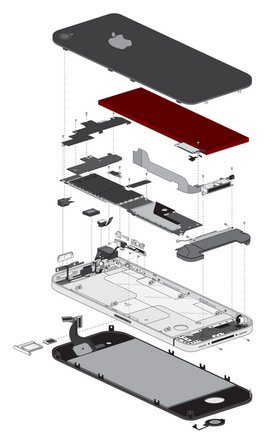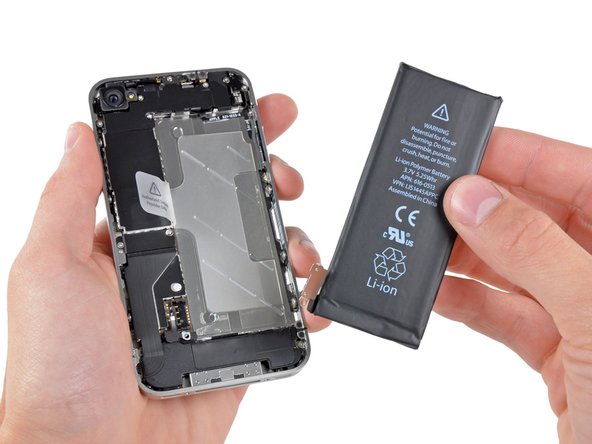We’re accustomed to planned obsolescence. New models come out every year—faster, shinier and just plain better. But before the iPhone, cell phones without user-replaceable batteries were almost unheard of. Apple realized that they could sell more phones if they built the phone with an integrated battery, prompting users to upgrade once the battery wore down. A phone isn’t very useful once you can’t take it away from the charger for more than an hour—which is guaranteed to happen with every iPhone. We’ve written extensively about Lithium-Ion batteries in the past—they’re wonderful technology, but they have a finite life of 300 to 500 cycles. If you’re like me and use up your battery completely every day, it’ll only last a year or so. (When I travel, I have to charge my phone at least twice a day.) Once the battery is worn down, it needs to be replaced—just like the light bulb in your refrigerator or the air filter in your car. Until the iPhone, all consumer product designs included a way to replace consumables. Apple’s consumer-hostile approach has turned product design on its head.
Imagine if rather than shipping inkjet printers with replaceable ink cartridges, HP forced you to buy a new printer every 400 pages. Or if Ford told you to buy a new car after 40,000 miles rather than replacing the brake pads! We would never tolerate such wasteful engineering—and yet somehow Apple has suckered us all into an involuntary annual upgrade cycle.
Apple defends themselves by claiming that you can always pay them to replace the battery. That’s true—it’s $85.95, takes a week, and Apple will erase your phone’s memory during the procedure. That’s the only way. There are no other officially sanctioned options—Apple refuses to authorize any independent iPhone battery replacement centers. Their onerous replacement procedure is intentionally expensive, because they don’t want you to replace the battery. Apple wants you to buy a new phone—but if you insist on doubling its lifespan by replacing your battery, they want to make some money in the process. Never mind that iPhone batteries retail for just $20, and cost Apple far less than that.

Users have two options: buy a new phone every year or so, or pay Apple $85.95 every year or so. Apple wins either way. They’re not selling us phones—they’re leasing them to us!
This isn’t just planned obsolescence—this is planned failure. Apple is making billions by selling us hardware with a built-in death clock. It is designed to fail after 400 cycles, conveniently coordinated with their annual hardware release cycle. Dead, hard to replace battery every year. New iPhone every year.
The current iPod Shuffle is the worst example of this. Replacing the battery is almost impossible—in our teardown last fall, the new Shuffle earned the worst repairability score we’ve ever given . This is the first product Apple has ever shipped where their price for battery replacement ($49 + $6.95 shipping) is higher than the retail price of the product ($49, free shipping)! Apple has clearly given up on replacing batteries and is just shipping people a replacement. The Shuffle’s intended design life is exactly the same as its battery, with no hope for extending it.
While the environmental and human consequences of this business strategy are dire, the financial impact is also substantial. This policy helped Apple make six billion dollars in just the last three months.

Fortunately, there’s a way to opt out of the annual hardware replacement cycle: replace your own battery. We’ve put everything in one place to make it as easy as possible—we have step-by-step replacement guides (original, 3G, 3GS, 4), tools, and batteries. Replacing your own battery saves you money, keeps expensive hardware from going to the landfill prematurely, and sends a message to manufacturers that you will not tolerate design for failure.
Apple sees self-replacement as a threat, and they are working on making it harder to open your own phone. That’s a battle that the iFixit community is prepared to fight.




2 Comments
Yet Apple atill has people wasting money on their iJunk. Apple was the first company to do this with the batteries with the iPod. Then came the iPhone, and when the other companies saw Apple with the tsunami of ill-gotten "earnings" they copycatted Apple. Apple started this trend all over. It's a crime against the environment. Is this is all they can do to "innovate"? Milk the consumer?
I buy my phones unlocked (GSM) and with a good size battery in the $300 range. If I have no choice but to buy phones with irreplaceable batteries, I refuse to pay $1400 for a glued together piece of junk with undersize battery designed to die. The best thing to do is to use the %#*@ phone as little as you can. OK, make and get calls and texts. But stop playing Candy Crunch, wasting time on Facebook, etc. and turn off features not needed like GPS services, push notifications, Bluetooth when not used, and if you DID fall for the iPhone 14, turn off that stupid battery-wasting always on display! Who came up with that eco-crime?
Michael Poulos - Reply
Even worse is the fact that Apple uses cryptography to ensure that parts cannot be replaced except by Apple-certified repair shops. They also have shipments of Apple-unsanctioned, yet nevertheless legitimate, replacement parts destroyed at borders because Apple will always call such parts counterfeits, even if you yourself harvested them from legitimate Apple devices.
Kargoneth - Reply